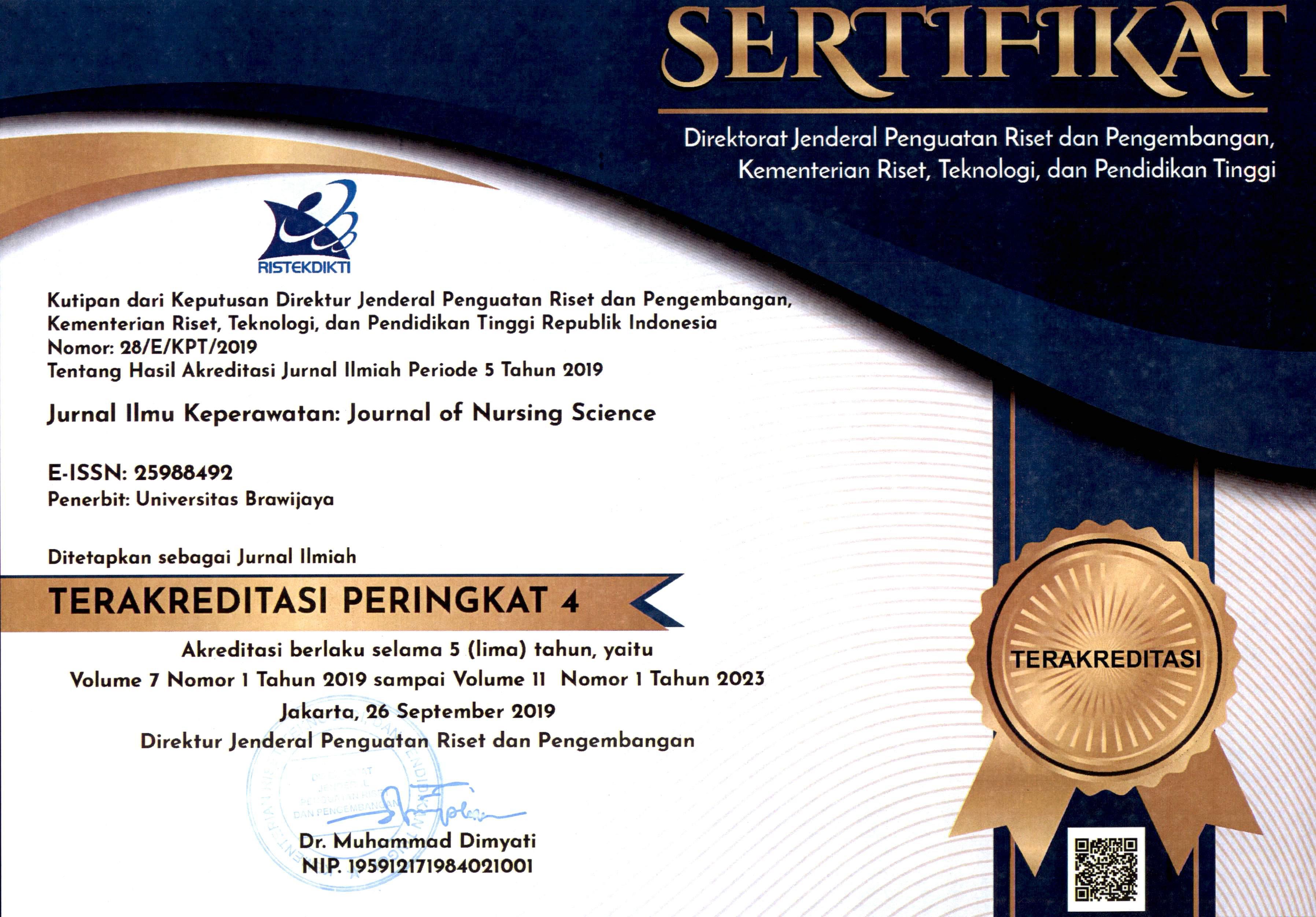Utilization of Adaptive Communication in End-Of-Life Care in Intensive Care Unit During the Covid-19 Pandemic: Literature Review
DOI:
https://doi.org/10.21776/ub.jik.2022.010.02.3Keywords:
Covid-19, End of life, Intensive Care Unit, CommunicationAbstract
Covid-19 is becoming a global pandemic that presents new challenges in critical care. Visitation restrictions and isolation are major challenges in end-of-life care communication. The use of communication as an indicator of the quality of end-of-life care in the critical care management chain is required to adapt creatively and effectively. The aim of this research is to know the description of communication in end-of-life care in intensive care units during the covid-19 pandemic based on literature sources related to scientific research journals. The research was conducted by searching for research results published in 2019-2021 from databases such as PubMed, google scholar, and science direct using the keywords "communication", "end-of-life", "intensive care unit", and "pandemic". The search results selected twelve articles that met the PICO analysis for review. Twelve articles explain that adaptive communication can be carried out between patients, families, and the medical team through continuous video and telephone calls. Long-distance communication is carried out by following special rules, namely on time, coordinated by the entire team, and environmental and patient readiness, both in outward appearance and hemodynamic status. Communication adaptations in other forms are described in more detail in the communication guide checklist and written information sheets, as well as efforts to increase the role and number of nursing staff in large-scale communications. The use of adaptive communication positively can be beneficial in improving the quality of end-of-life care in intensive care units during a pandemic.
References
- Cardona, M., Anstey, M., Lewis, E. T., Shanmugam, S., Hillman, K., & Psirides, A. (2020). Appropriateness of intensive care treatments near the end-of-life during the covid-19 pandemic. Breathe, 16(2), 1–10. https://doi.org/10.1183/20734735.0062-2020
- Ersek, M., Smith, D., Griffin, H., Carpenter, J. G., Feder, S. L., Shreve, S. T., Nelson, F. X., Kinder, D., Thorpe, J. M., & Kutney-Lee, A. (2021). End-Of-Life Care in the Time of COVID-19: Communication Matters More Than Ever. Journal of Pain and Symptom Management, 62(2), 213-222.e2. https://doi.org/10.1016/j.jpainsymman.2020.12.024
- Estella, Á. (2020). Compassionate Communication and End-of-Life Care for Critically Ill Patients with SARS-CoV-2 Infection. New England Journal of Medicine, 382(24), e88. https://doi.org/10.1056/nejmp2007781
- Feder, S., Smith, D., Griffin, H., Shreve, S. T., Kinder, D., Kutney-Lee, A., & Ersek, M. (2021). “Why Couldn’t I Go in To See Him?” Bereaved Families’ Perceptions of End-of-Life Communication During COVID-19. Journal of the American Geriatrics Society, 69(3), 587–592. https://doi.org/10.1111/jgs.16993
- Galazzi, A., Binda, F., Gambazza, S., Lusignani, M., Grasselli, G., & Laquintana, D. (2021). Video calls at end-of-life are feasible but not enough: A 1-year intensive care unit experience during the coronavirus disease-19 pandemic. Nursing in Critical Care, 26(6), 531–533. https://doi.org/10.1111/nicc.12647
- Grasselli, G., Pesenti, A., & Cecconi, M. (2020). Critical Care Utilization for the COVID-19 Outbreak in Lombardy, Italy: Early Experience and Forecast during an Emergency Response. In JAMA - Journal of the American Medical Association (Vol. 323, Issue 16, pp. 1545–1546). American Medical Association. https://doi.org/10.1001/jama.2020.4031
- Hebert, K., Moore, H., & Rooney, J. (2011). The Nurse Advocate in End-of-Life Care.
- Jackson, D., Bradbury-Jones, C., Baptiste, D., Gelling, L., Morin, K., Neville, S., & Smith, G. D. (2020). Life in the pandemic: Some reflections on nursing in the context of COVID-19. In Journal of Clinical Nursing (Vol. 29, Issues 13–14, pp. 2041–2043). Blackwell Publishing Ltd. https://doi.org/10.1111/jocn.15257
- Jeitziner, M. M., Camenisch, S. A., Jenni-Moser, B., Schefold, J. C., & Zante, B. (2021). End-of-life care during the COVID-19 pandemic—What makes the difference? In Nursing in Critical Care (Vol. 26, Issue 3, pp. 212–214). Blackwell Publishing Ltd. https://doi.org/10.1111/nicc.12593
- Negro, A., Mucci, M., Beccaria, P., Borghi, G., Capocasa, T., Cardinali, M., Pasculli, N., Ranzani, R., Villa, G., & Zangrillo, A. (2020). Introducing the Video call to facilitate the communication between health care providers and families of patients in the intensive care unit during COVID-19 pandemia. In Intensive and Critical Care Nursing (Vol. 60). Churchill Livingstone. https://doi.org/10.1016/j.iccn.2020.102893
- Nelson, J. E., Puntillo, K. A., Pronovost, P. J., Walker, A. S., McAdam, J. L., Ilaoa, D., & Penrod, J. (2010). In their own words: Patients and families define high-quality palliative care in the intensive care unit *.
- Pattison, N. (2020). End-of-life decisions and care in the midst of a global coronavirus (COVID-19) pandemic. In Intensive and Critical Care Nursing (Vol. 58). Churchill Livingstone. https://doi.org/10.1016/j.iccn.2020.102862
- Piazza, O., & Cersosimo, G. (2015). Communication as a basic skill in critical care. In Journal of Anaesthesiology Clinical Pharmacology (Vol. 31). http://www.journalonweb.com.
- Raftery, C., Lewis, E., & Cardona, M. (2020). The Crucial Role of Nurses and Social Workers in Initiating End-of-Life Communication to Reduce Overtreatment in the Midst of the COVID-19 Pandemic. Gerontology, 66(5), 427–430. https://doi.org/10.1159/000509103
- Rose, L., Yu, L., Casey, J., Cook, A., Metaxa, V., Pattison, N., Rafferty, A. M., Ramsay, P., Saha, S., Xyrichis, A., & Meyer, J. (2021). Communication and virtual visiting for families of patients in intensive care during the COVID-19 pandemic: A UK national survey. Annals of the American Thoracic Society, 18(10), 1685–1692. https://doi.org/10.1513/AnnalsATS.202012-1500OC
- Shead, D. C., Ahmed, N., & Davids, R. A. (2021). Let’s talk about It: What COVID-19 has taught a South African intensive care unit about communication. In Dimensions of Critical Care Nursing (Vol. 40, Issue 3, pp. 135–138). Lippincott Williams and Wilkins. https://doi.org/10.1097/DCC.0000000000000474
- Spinello, I. M. (2011). End-of-life care in ICU: A practical guide. In Journal of Intensive Care Medicine (Vol. 26, Issue 5, pp. 295–303). https://doi.org/10.1177/0885066610392697
- ten Hoorn, S., Elbers, P. W., Girbes, A. R., & Tuinman, P. R. (2016). Communicating with conscious and mechanically ventilated critically ill patients: A systematic review. Critical Care, 20(1).
- Tika Anggraeni, D., Tangkabiringan, D., & Dea Rosaline, M. (2020). Nurses Experience in End-of-life Decision-Making for Covid-19 Patients in the Intensive Care Unit.
Downloads
Published
How to Cite
License
Copyright (c) 2023 Journal of Nursing Science Update

This work is licensed under a Creative Commons Attribution-NonCommercial 4.0 International License.
Authors published in this journal agree to the following terms:
1. The copyright of the received article shall be assigned to the journal as the publisher of the journal. The intended copyright includes the right to publish the article in various forms (including reprints). The journal maintains the publishing rights to the published articles.
2. Authors may enter into separate additional contractual agreements for the non-exclusive distribution of the published journal version of the work (for example, posting it to an institutional repository or publishing it in a book), with acknowledgment of their initial publication in this journal.
3. Authors are permitted and encouraged to post their work online (e.g. in an Institutional Repository or on their website) before and during the submission process, as this can result in a productive exchange, as well as earlier and larger citations of the published work.
4. Articles and all related material published are distributed under Creative Commons Attribution-NonCommercial 4.0 International License or CC BY-NC 4.0 license.
JNSU is licensed under a Creative Commons Attribution-NonCommercial 4.0 International License or CC BY-NC 4.0 license.






























